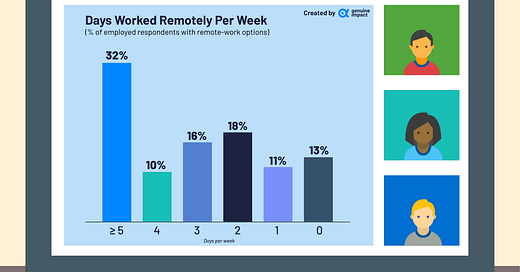Today’s newsletter takes a look at jobs and working lives of today. We visualise how many days of the week people are still working from home, and how employment rates have changed over time in the US and Great Britain. Also, which countries have the longest working hours, and does their pay make up for it? Finally, what do retirement ages look like across the G20 countries?
Are you still working remotely? 🏝
Covid no doubt had a huge role to play in popularising working from home. While some companies have chosen to fully embrace this, others are expecting workers to return to offices. We take a look at how often Americans are coming into offices, as of Spring 2022. Over 30% of Americans that were offered the option to WFH are working pretty much fully remotely. Following this, others are taking a hybrid approach going into the office 2-3 days a week. 13% that have been offered WFH are clearly much happier coming into the office and do not work remotely at all.
Employment rates
Taking a look at the employment rates for both Great Britain and the US, we can see that they follow each other quite closely. However, in the time period visualised, the United States’ employment rate is consistently below Great Britain’s. Also, the US’ fluctuations tend to be a lot more dramatic, for example when you see how much the employment rate dipped during the financial crisis and Covid-19.
Check Your Home's Climate Risk at Habitable!
Habitable's free climate risk tool gives you an instant snapshot of your property's risk for flood, fire, heat and drought.
*this is sponsored advertising content
Working Hours vs. Salary
We visualise how hard OECD member countries are working by taking a look at what their average number of working hours are per week and also their typical weekly wage. It’s pretty clear that Mexicans have gotten the short end of the stick with the highest average working hours per week and lowest weekly wage (check out our friends at Latinometrics for more data vizzes on Latin American markets!).
In fact, there does appear to be somewhat of a negative correlation where those countries that work the least number of hours actually tend to earn more. The highest earners are unsurprisingly made up of mainly western European nations that are more developed. It is also important to remember that these countries will also have different costs of living, for example while Luxembourg and Switzerland may have the highest salaries, these countries tend to be more expensive to live in.
Retirement ages across countries
Retirement ages vary across G20 countries, for example countries like Italy and the Netherlands have the highest ages at 67 and 66.6, respectively (as of December 2022). However, many of the Asian countries in G20 set their retirement ages much lower such as Indonesia at only 58. Retirement age policies can change over time due to various factors such as economic considerations, shifts in life expectancy, and evolving social security systems.
See you on Wednesday for charts on relationships!
This newsletter started free, and we aim to keep it free for as long as we can. However, any support is always much appreciated - feel free to buy us a coffee using the link below <3










